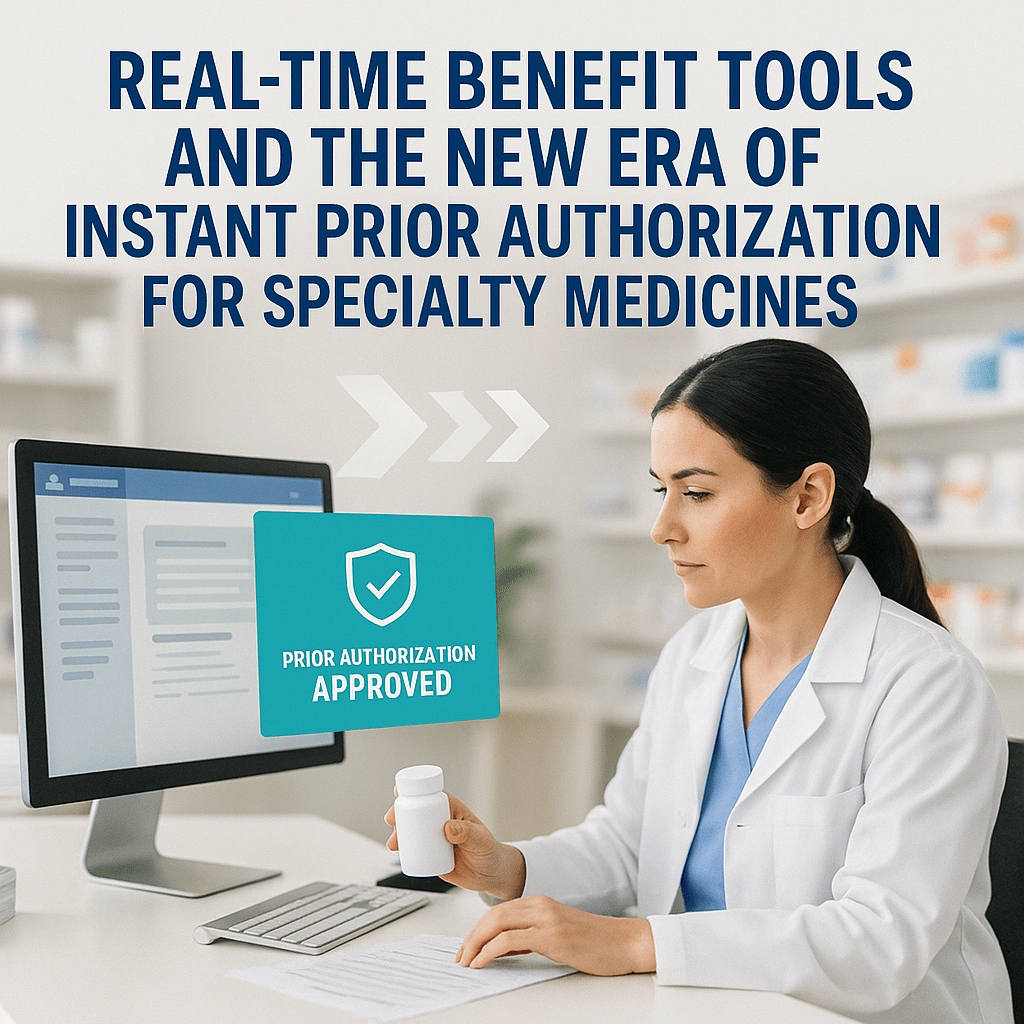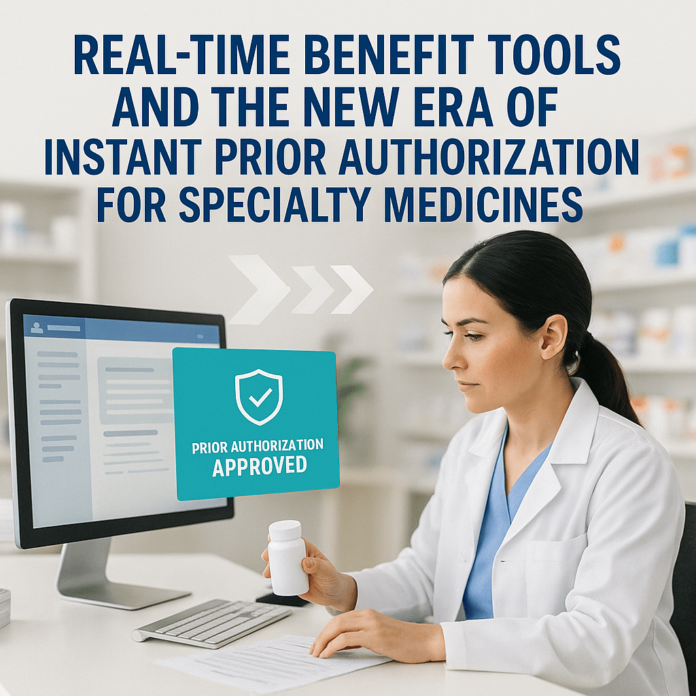Instant Prior Authorization Begins at the Prescription Screen
Instant prior authorization—once a pipe dream for oncologists and rheumatologists—now flashes across many electronic prescribing screens in under two seconds. The moment a clinician selects a specialty medicine, a real-time benefit tool reaches out to the patient’s health-plan rule engine and returns three decisive answers: whether the drug is covered, what the patient will pay, and whether prior authorization is needed. If approval is required, the correct electronic questionnaire opens already populated with chart data, allowing the prescriber to submit the request before the patient leaves the room.
That single exchange replaces an average of three to seven business days of back-and-forth faxes, portal uploads, and phone calls. For a person with metastatic breast cancer or severe Crohn’s disease, shaving even twenty-four hours off the approval cycle can prevent organ damage, spare hospital days, and in some cases improve survival odds.

Why Real-Time Benefit Tools Matter Most for High-Cost Specialty Therapies
Specialty prescriptions account for fewer than two percent of pharmacy claims yet consume more than half of every commercial plan’s drug budget. Each abandoned biologic order wastes thousands of dollars in acquisition and handling fees, and every delay increases the risk that the patient will never start therapy. By surfacing plan-specific cost information and utilization rules at prescribing time, real-time benefit tools let clinicians pivot to an equally effective, lower-tier alternative on the spot. Studies show that when the prescriber and patient view out-of-pocket liability before the order is transmitted, primary non-adherence drops by several percentage points.
How the Technology Works Behind the Scenes
When a prescriber clicks “Submit,” the real-time benefit tool bundles the National Drug Code (NDC), the patient’s insurance identifiers, and basic demographics into a Fast Healthcare Interoperability Resources (FHIR) API request. The health plan’s utilization-management engine then checks the drug against its formulary, accumulator ledger, and clinical-policy library. In under one second, the response returns the drug’s coverage status, the patient’s real-time cost share, and a flag indicating whether prior authorization (PA) is required. If a PA is needed, the tool launches the appropriate structured questionnaire, built to the National Council for Prescription Drug Programs (NCPDP) SCRIPT v2023011 standard. Because the form is pre-populated with diagnosis codes, lab values, and body-weight data, most clinicians simply add a brief free-text note before clicking “Send.”
Outdated Workflows the Tools Eliminate
Traditional specialty-drug approval is slow for three reasons. First, most clinics still fax documents or re-enter data into external web portals, virtually guaranteeing incomplete submissions. Second, payer clinical policies often exceed 5000 pages, making it impossible for a busy physician to know whether a specific tumor mutation or treatment stage satisfies coverage rules. Third, discrepancies between what the prescriber writes and what the pharmacy can legally dispense, such as quantity limits, trigger yet another loop of phone calls. Real-time benefit tools remove guesswork by exposing the rule book directly inside the prescribing workflow and by validating quantity limits and step-therapy requirements before the order ever reaches the pharmacy.
Regulation Is Turning an Innovation into a Mandate
Federal regulators have added rocket fuel to adoption. The Centers for Medicare and Medicaid Services issued the Interoperability and Prior Authorization Final Rule in January 2024, which requires the largest Medicare Advantage, Medicaid, and Affordable Care Act plans to answer routine prior-authorization requests within seventy-two hours and urgent requests within twenty-four hours by 2026. The same rule forces payers to provide a standards-based application-programming interface so that electronic health-record vendors can query benefit and authorization data in real time. Separately, the Medicare Part D real-time benefit requirement compels plan sponsors to deliver patient-specific drug pricing and clinically appropriate alternatives at the moment of prescribing. With these regulations in place, fax-based workflows are rapidly becoming non-compliant as well as inefficient.
Early Evidence of Industry-Wide Impact
Payers and pharmacy-benefit managers are already acting. In March 2025 Optum Rx announced that it would eliminate up to twenty-five percent of annual reauthorization requirements, starting with around eighty drugs, to reduce administrative overhead and speed access to therapy. Internal analyses showed that removing redundant paperwork for chronic-disease agents not only shortens approval cycles but also frees clinical staff for more complex cases.
Benefits for Providers, Payers, Pharmacies, and Patients
Physicians and hospital networks report dramatic gains in staff productivity. A coordinator who once processed fifteen oncology approvals in a day can now close forty or fifty, because the real-time questionnaire arrives pre-filled with chart data. Health plans avoid “pay-and-chase” scenarios in which a specialty pharmacy ships a drug worth tens of thousands of dollars only for the claim to be denied later. Pharmacies receive clean electronic prescriptions with all coverage checks complete, driving shorter dispense times and higher patient retention. Most importantly, patients see earlier therapy starts and immediate visibility into their out-of-pocket costs, reducing surprise bills and improving adherence.
Steps to Implement a Real-Time Benefit Tool in a Large Health-System Network
Successful deployment begins with governance. A cross-functional steering committee—comprised of revenue-cycle leaders, pharmacy directors, information-technology architects, and frontline clinicians—establishes clear goals such as halving manual prior-authorization touches within six months. The health-system then evaluates vendors for network reach, payer connectivity, and guaranteed response times under two seconds for ninety-five percent of queries. After contracting, the information-technology team installs a SMART-on-FHIR application inside the electronic record, maps vocabulary sets, and runs hundreds of simulated prescriptions. Training emphasizes that clinicians can complete an approval in under one minute. Post-launch dashboards track median approval time, percentage of prescriptions that bypass prior authorization entirely, and the number of therapy starts delayed for administrative reasons.
Measuring Return on Investment without Abbreviations
Speed to therapy is the headline metric. Clinics that waited three business days for approval now report median response times closer to six minutes. Prescription abandonment for high-cost self-injected biologics has fallen from roughly fifteen percent to single digits, because patients never encounter surprise hundred-dollar or thousand-dollar copays at the pharmacy. On the labor side, each coordinator freed from repetitive data entry can be redeployed to patient education or financial-assistance enrollment. Financially, health systems record fewer denials for exceeding quantity limits or using the wrong distribution channel, while specialty pharmacies capture revenue that previously bled to alternate dispensing locations.
Remaining Hurdles and Practical Work-Arounds
A minority of regional health plans still lack a standards-based interface. Clinics can temporarily generate a pre-populated Portable Document Format from the real-time benefit tool and transmit it via secure messaging until the payer’s interface goes live. Deductible resets every January occasionally misprice patient cost shares, a problem mitigated by nightly accumulator refreshes and on-screen confidence ratings. Infused therapies billed under the medical benefit, rather than the pharmacy benefit, still require a separate workflow built on the Fast Healthcare Interoperability Resources Prior Authorization approach championed by the Da Vinci project. Finally, alert fatigue can blunt adoption if every generic antibiotic triggers a pop-up, so health-systems configure the tool to flag only high-tier medicines with wholesale-acquisition costs above one thousand dollars.
Five Trends That Will Push Instant Prior Authorization Even Further
Artificial-intelligence copilots will soon draft full responses to payer questionnaires by reading the patient chart, inviting the clinician to approve with one click. Industry analysts forecast that by 2027 three-quarters of all electronic prior authorizations will auto-approve without additional typing. Patient-facing versions of real-time benefit tools will let consumers price-check therapies before appointments, encouraging shared decision-making. Conversational bots will automatically match eligible patients to manufacturer coupon cards or nonprofit foundations and attach digital vouchers to the claim in real time. The same rule engines that process pharmacy benefits are now being adapted to radiology imaging, genetic testing, and inpatient infusion suites, promising enterprise-wide administrative savings. Finally, live data feeds from these tools will populate value-based-contract dashboards, allowing health plans to reconcile outcome-based rebates monthly instead of annually.
Conclusion—From Fax Noise to Two-Second Decisions
Real-time benefit tools do more than shave hours off paperwork. By combining formulary transparency, cost-share accuracy, and electronic prior-authorization questionnaires in a single workflow, they transform a week-long paper chase into a two-second digital handshake. Instant prior authorization is no longer futuristic jargon; it is a regulatory requirement, a competitive advantage, and, most importantly, a clinical imperative. Health-systems and payers that embrace this technology will deliver therapies faster, spend administrative dollars more wisely, and meet patient expectations for modern, friction-free care. Those that cling to fax machines risk not just inconvenience but irrelevance in a marketplace where speed is measured in milliseconds and lives can hinge on the difference.




